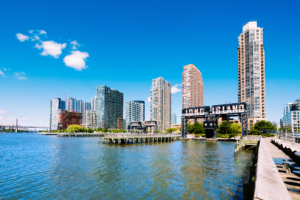As you start your property search, you’re likely focused on a few main criteria: Price, space and location. These are all essential considerations for your home search. Obviously, you want something you can afford in a neighborhood you desire with a space that serves your needs. Just like you, everyone is looking for the best deal. So naturally, buyers start by looking at the sales price. However, cheaper doesn’t always mean it’s the better deal and that’s where price per square foot comes in.
For instance, let’s say you’re comparing a few two-bedroom apartments:
- Apartment A is priced at $1.3 million and has 950 square feet
- Apartment B is priced at $1.2 million and has 810 square feet
You might immediately say that the $1.2 million apartment is the better deal. However, what you should really be looking at is the price per square foot, which you get by dividing the sales price by the square footage.
Calculation
Price per square foot (PPSF) = Sales price / square footage
- Apartment A PPSF = $1,300,000 / 950 square feet = $1,368 per square foot
- Apartment B PPSF = $1,200,000 / 810 square feet = $1,481 per square foot
Result: Apartment B is $113 more per square foot!
Why Is PPSF Difference Valuable?
At first glance, it seems that Apartment B is actually cheaper and the better deal from an absolute price point perspective. However, when you take a look at the price per square foot, you see that Apartment B actually has a much higher square footage cost. Each square foot of indoor space in Apartment B will cost you $113 more than Apartment A. Looking at the PPSF, you may actually deem that apartment A is the better deal here, as opposed to Apartment B.
However, knowing that Apartment A is the better deal based on PPSF may not provide consolation to the fact that it’s still $100,000 more expensive than the other apartment. This may have an impact on your ability to purchase the property, despite being the better of the two deals.
What Impacts Price Per Square Foot?
Price per square foot is often dictated by several important factors. Neighborhood location and building type are two things that greatly impact the PPSF. For instance, desirable neighborhoods will command a higher PPSF than less desirable neighborhoods. Additionally, newer construction buildings with richer amenity spaces will command higher PSFs than older buildings. On average, condos will have higher PPSFs than co-ops because condos attract capital from investors, while co-ops generally don’t.
One other thing to note that has lots of influence on the PPSF is outdoor space. Outdoor space doesn’t actually get counted in the square footage number that is reported and therefore doesn’t make its way into the traditional PPSF calculation. Therefore, a property may seem to have a high PPSF, but it may actually be offset by the fact that there’s outdoor space for which a buyer would pay a premium.
How Do You Spot a Good Deal?
From a personal opinion, you can either chase prices or you can chase trends. Sure, you want to look at the absolute price points as well as the price per square foot, but where I find the most exciting opportunities is identifying properties where the PPSF is starting to trend upwards. One could argue that the entire city continues to trend upward. However, you can focus on neighborhoods that have traditionally seen low price per square foot that are seeing an influx of new development, which will result in a lifting tide for PPSFs across the entire neighborhood. This goes back to the idea of neighborhood desirability having a significant impact on the PPSF.
How do you go about identifying trends with upside potential? That will be a topic for further writing, but I do recommend following the artists to find up and coming neighborhoods.
Related:









